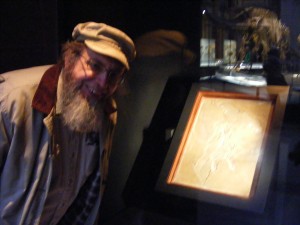 Made the pilgrimage to Berlin to visit the Museum of Nature (Museum fur Naturkunde). The Archeopterix is beautifully displayed. Every few seconds the angle of the lighting changes so you can see different details. We of course have a copy of this in our museum (still unfinished display in the south stairwell) but a copy does not show the detail. The feathers plainly shout “bird” even while the bones are essentially dinosaur. The specimen shows no evidence of preparation even though it is inconceivable to me that it simply broke out of the matrix this way.
Made the pilgrimage to Berlin to visit the Museum of Nature (Museum fur Naturkunde). The Archeopterix is beautifully displayed. Every few seconds the angle of the lighting changes so you can see different details. We of course have a copy of this in our museum (still unfinished display in the south stairwell) but a copy does not show the detail. The feathers plainly shout “bird” even while the bones are essentially dinosaur. The specimen shows no evidence of preparation even though it is inconceivable to me that it simply broke out of the matrix this way.
And there is something else in this museum, nowhere near as well known but perhaps scientifically just as important. The Museum of Nature also has the Ehrenburg collection. Christian Ehrenberg (1795-1876) was one of the great scientist explorers of that early gold age of natural history where we were just beginning to figure out the diversity of the natural world. While everyone else was chasing the animals of Africa and the insects of Brazil, Ehrenberg hunted his big game with the microscope. For maybe twenty years he had the whole microscopic world to himself, and he made the initial descriptions of, well, anything that is small. People from all over the world, including Darwin, Alexander Graham Bell and cowboys in the American West would collect a water sample or some mud and send it to Ehrenberg. And he would look at and describe it all.
This collection sits in wood cabinets in Berlin. Ehrenberg mounted his specimens on pieces of muscovite, which were considered better than the glass slides of the day. On the muscovite he spread a mounting medium (Canada balsam) and then sprinkled his sample. The collection has 40,000 of these muscovite slides, all with his hand-written labels and with some 3000 pages of his notes and drawings. There are perhaps thousands of type specimens here, which are still being examined. The collection includes the frst silicoflagellates ever observed by humans. There is also all the samples that people sent him from all over, in pickle jars and pill boxes, with the notes from whoever thought this might be of interest to Ehrenberg.
This is the third natural history museum that I am reviewing in this blog. The museum in Berlin is one of the world class museums. The Branchiosaurus here is the largest mounted dinosaur in the world, and is spectacular with head that must be ten meters above ground level. But the gift shop was a disappointment. The trend has been for science museum gift shops to go to just kid stuff. Stuffed animals and puppets and children’s books. I wanted gifts for friends – and a dinosaur coffee mug for myself. No chance. I was hardpressed to find anything with an Archeopterix on it – picked up a few postcards and refrigerator magnets. The Smithsonian museums have pretty much gone the same way. Maybe someone has figured that there is more profit to be made in selling toys, but it is adults who are taking the kids there and we need to have our intellects and shopping needs taken care of as well…
